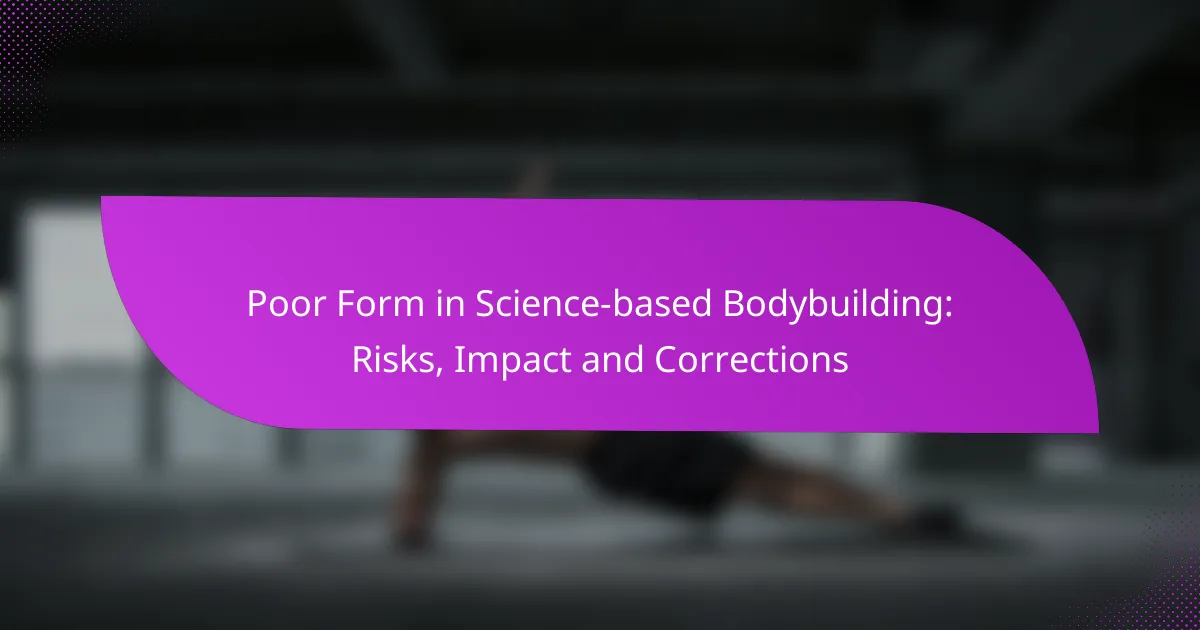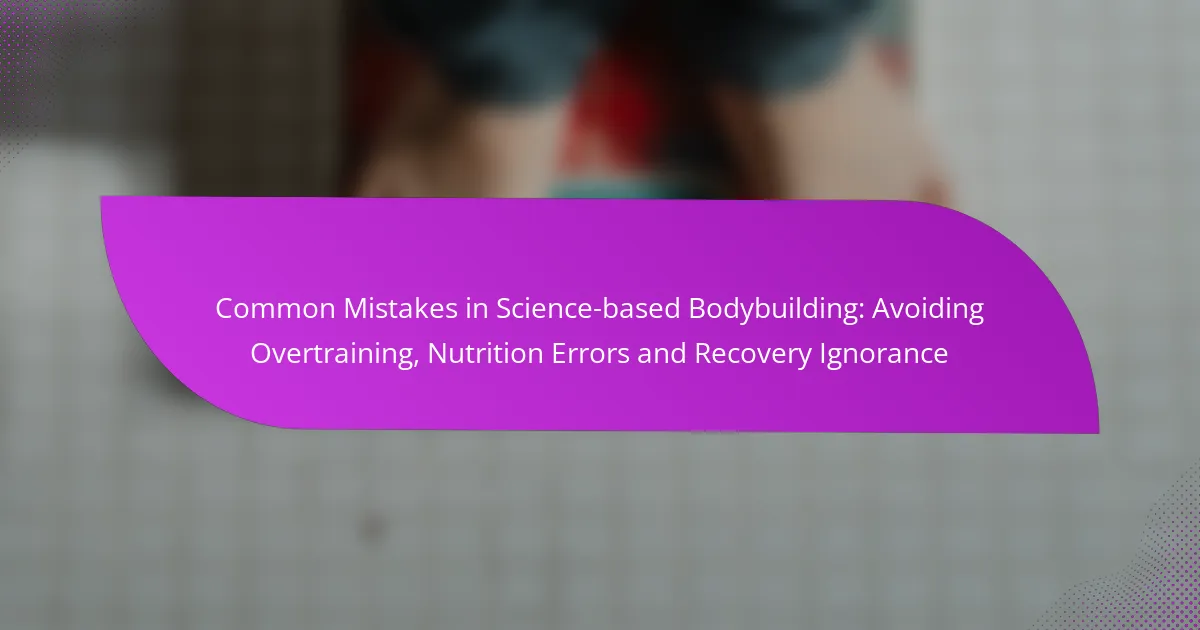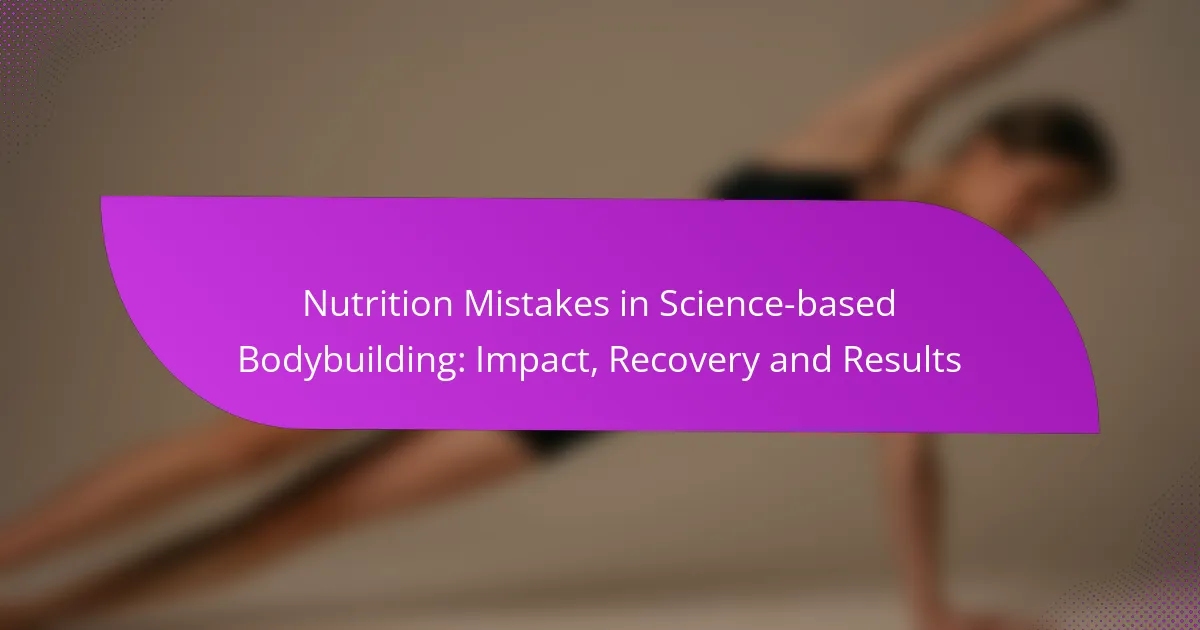Poor form in science-based bodybuilding poses serious risks, including injuries and long-term health issues, while also hindering performance and muscle development. Proper technique is crucial not only for safety but also for maximizing strength and endurance. Implementing effective corrections through feedback, professional guidance, and targeted exercises can significantly enhance performance and minimize injury risk.

What Are the Risks of Poor Form in Bodybuilding?
Poor form in bodybuilding can lead to significant risks, including injuries and long-term health complications. Maintaining proper technique is essential not only for safety but also for effective muscle development.
Injury potential
Using improper form while lifting weights increases the likelihood of acute injuries, such as strains, sprains, and fractures. Common examples include back injuries from deadlifts performed with a rounded spine or shoulder injuries from bench presses with incorrect grip width.
To minimize injury risk, focus on mastering the correct techniques before increasing weights. Consider working with a certified trainer to ensure your form is correct, especially when performing complex movements.
Long-term health issues
Consistently lifting with poor form can lead to chronic conditions, including joint pain and musculoskeletal disorders. Over time, these issues may require medical intervention or physical therapy, impacting your overall fitness journey.
To avoid long-term health problems, regularly assess your lifting technique and prioritize mobility and flexibility exercises. Incorporating rest days and cross-training can also help maintain overall body health.
Impact on muscle development
Improper form not only increases injury risk but also hinders muscle growth. When exercises are performed incorrectly, the targeted muscles may not be effectively engaged, leading to suboptimal results.
To enhance muscle development, ensure that you are using the correct range of motion and engaging the intended muscle groups. Tracking your progress and adjusting your form as needed can lead to better outcomes in strength and size.

How Does Poor Form Affect Performance?
Poor form in bodybuilding can significantly hinder performance by limiting strength, endurance, and overall technique. When exercises are performed incorrectly, the body may not engage the intended muscles effectively, leading to suboptimal results and increased risk of injury.
Reduced strength gains
Using improper form during workouts can lead to reduced strength gains, as the targeted muscles may not be fully activated. For instance, if a lifter rounds their back during a deadlift, they may rely more on their lower back instead of engaging their glutes and hamstrings. This can result in weaker lifts and a plateau in progress.
To maximize strength development, focus on maintaining proper alignment and technique. Consider working with a trainer to ensure exercises are performed correctly, which can lead to more effective workouts and better results over time.
Decreased endurance
Endurance can also suffer when exercises are performed with poor form. When the body compensates for incorrect movements, it may fatigue more quickly, leading to shorter workout sessions. For example, if a person uses momentum instead of muscle control during a squat, they may tire out faster and be unable to complete their intended sets.
To improve endurance, prioritize form over weight. Start with lighter weights to master the technique before gradually increasing the load. This approach can enhance stamina and allow for longer, more productive workouts.
Impaired technique
Consistently using poor form can lead to impaired technique, making it difficult to perform exercises correctly over time. This can create a cycle where bad habits become ingrained, increasing the risk of injury and further diminishing performance. For example, improper shoulder positioning during a bench press can lead to shoulder pain and limit the ability to lift effectively.
To correct technique, regularly assess your form through video recordings or feedback from experienced lifters. Incorporating drills that focus on specific movements can also help reinforce proper mechanics and build a solid foundation for future progress.

What Are Effective Corrections for Poor Form?
Effective corrections for poor form in bodybuilding focus on enhancing technique and preventing injury. By utilizing feedback mechanisms, professional guidance, and targeted exercises, individuals can improve their performance and achieve better results.
Utilizing mirrors for feedback
Mirrors are a valuable tool for correcting poor form in bodybuilding. They provide immediate visual feedback, allowing you to observe your posture and alignment during exercises. Regularly checking your form in the mirror can help you identify and adjust any discrepancies in your technique.
When using mirrors, focus on key aspects such as back alignment, knee positioning, and shoulder placement. This can prevent common mistakes, such as rounding your back during lifts or letting your knees cave inward. Aim to practice in front of a mirror consistently to develop muscle memory for proper form.
Working with a personal trainer
Engaging a personal trainer can significantly enhance your ability to correct poor form. Trainers offer expert guidance, personalized feedback, and tailored workout plans that address your specific needs. They can identify subtle form issues that you might overlook and provide immediate corrections.
When selecting a trainer, look for someone with experience in bodybuilding and a strong understanding of biomechanics. Regular sessions can help you build confidence in your technique and ensure that you are performing exercises safely and effectively.
Implementing corrective exercises
Corrective exercises are designed to address specific weaknesses or imbalances that contribute to poor form. These exercises focus on strengthening underactive muscles and improving flexibility in overactive areas. For example, incorporating glute bridges can enhance hip stability, while shoulder mobility drills can improve overhead lifting form.
To implement corrective exercises effectively, assess your individual needs and target areas that require improvement. Aim to integrate these exercises into your routine at least two to three times a week, focusing on quality over quantity. This approach will help reinforce proper movement patterns and support your overall bodybuilding goals.

What Are the Best Practices for Maintaining Proper Form?
Maintaining proper form in bodybuilding is essential to prevent injuries and maximize effectiveness. Key practices include warming up adequately, ensuring core stability, and applying progressive overload principles.
Warm-up routines
A proper warm-up routine prepares your muscles and joints for the workout, reducing the risk of injury. Aim for 5-10 minutes of light cardio followed by dynamic stretches targeting the muscles you plan to use.
Incorporate movements such as arm circles, leg swings, and torso twists to increase blood flow and flexibility. This approach not only enhances performance but also improves overall workout efficiency.
Focus on core stability
Core stability is crucial for maintaining proper form during exercises. A strong core supports your spine and helps you perform movements with better alignment, reducing the risk of strain.
Exercises like planks, bridges, and rotational movements can enhance core strength. Aim to include core stability work in your routine at least 2-3 times per week for optimal results.
Progressive overload principles
Progressive overload involves gradually increasing the weight, frequency, or intensity of your workouts to stimulate muscle growth. This principle is vital for improving strength and maintaining proper form as you advance.
Start with weights that allow you to complete your sets with good form, then increase the load by small increments, typically 5-10% when you can perform the desired repetitions comfortably. This method helps prevent injury while promoting continuous improvement.

How Can Technology Aid in Correcting Form?
Technology can significantly assist in correcting form by providing real-time feedback and analysis, helping individuals identify and rectify improper techniques during workouts. Various tools, such as wearable fitness trackers, video analysis apps, and virtual coaching platforms, offer unique features that enhance performance and safety.
Wearable fitness trackers
Wearable fitness trackers monitor various metrics like heart rate, movement patterns, and exercise intensity, which can indirectly indicate form issues. For example, if a tracker shows unusual spikes in heart rate during specific exercises, it may suggest that the user is overexerting themselves due to poor technique.
When selecting a fitness tracker, look for models that offer detailed movement analysis and have features like accelerometers or gyroscopes. These can provide insights into your range of motion and help ensure that you are performing exercises correctly.
Video analysis apps
Video analysis apps allow users to record their workouts and analyze their form frame by frame. This can be particularly useful for identifying subtle mistakes that may not be apparent during live sessions. Many apps offer features like slow-motion playback and side-by-side comparisons with ideal form videos.
To effectively use these apps, record your exercises from multiple angles and focus on key movements. Look for common issues such as improper alignment or uneven weight distribution, and use the feedback to make necessary adjustments in your routine.
Virtual coaching platforms
Virtual coaching platforms connect users with professional trainers who can provide personalized feedback on form through video calls or uploaded content. This real-time interaction allows for immediate corrections and tailored advice based on individual performance.
When choosing a virtual coaching platform, consider factors such as the coach’s expertise and the platform’s features, like video sharing and progress tracking. Regular sessions can help reinforce proper techniques and keep you accountable in your bodybuilding journey.

What Are Common Misconceptions About Form in Bodybuilding?
Many bodybuilders underestimate the importance of proper form, believing that lifting heavier weights is the key to progress. Misconceptions include the idea that form can be sacrificed for weight or that injuries are an inevitable part of training. Understanding the significance of maintaining correct posture and technique is crucial for effective and safe bodybuilding.
Understanding Proper Form
Proper form in bodybuilding refers to executing exercises with the correct posture and technique to maximize effectiveness while minimizing injury risk. This involves aligning the body appropriately, using controlled movements, and engaging the right muscle groups. Each exercise has specific form requirements that should be adhered to for optimal results.
For instance, during a squat, the knees should track over the toes, and the back should remain straight to prevent strain. Familiarizing oneself with these nuances can significantly enhance workout outcomes.
Common Mistakes in Form
Common mistakes include rounding the back during lifts, using momentum instead of muscle strength, and neglecting to engage core muscles. These errors can lead to injuries and hinder progress. For example, improper deadlift form can strain the lower back, while poor bench press technique can cause shoulder injuries.
To avoid these pitfalls, it’s essential to focus on controlled movements and to start with lighter weights until the form is perfected. Regularly reviewing one’s technique, possibly with the help of a trainer, can also be beneficial.
Correcting Poor Form
Correcting poor form requires a systematic approach. Start by identifying specific issues through self-assessment or professional evaluation. Video analysis can be particularly helpful in pinpointing errors in technique.
Once issues are identified, practice the movement with lighter weights or even without weights to reinforce correct form. Gradually increase the load as confidence and technique improve. Additionally, incorporating flexibility and strength training for supporting muscles can enhance overall stability and performance.



